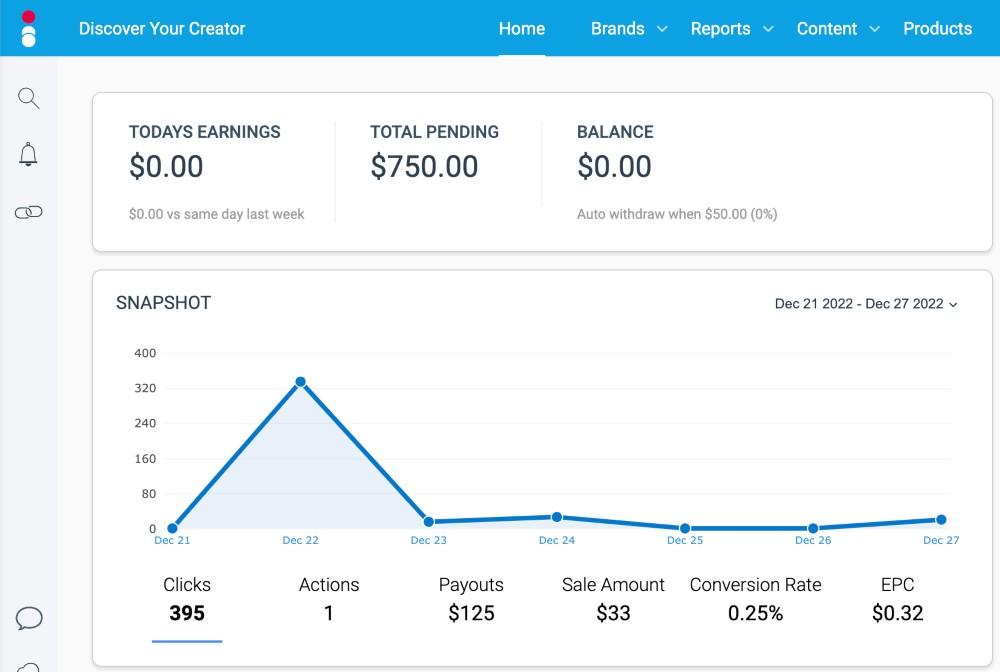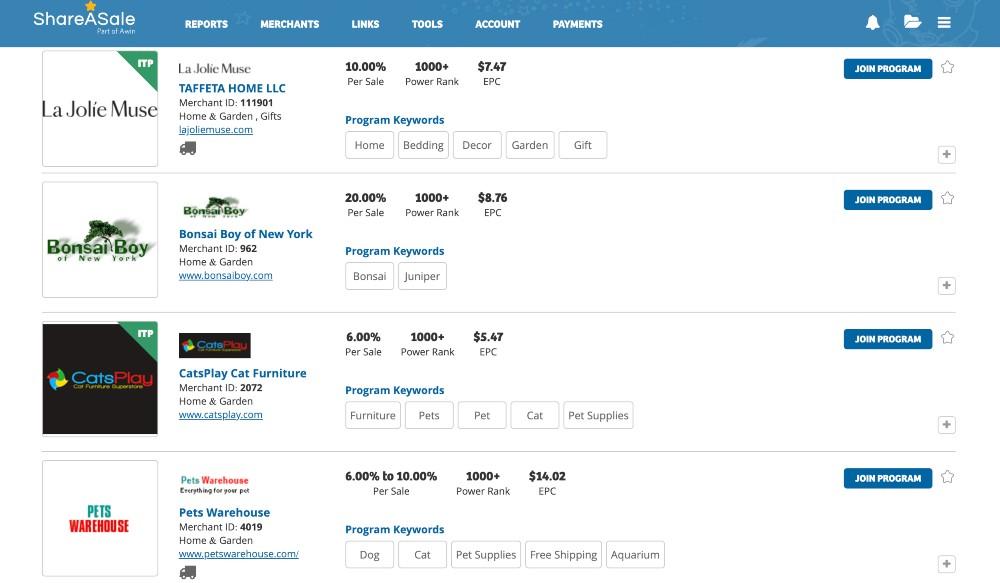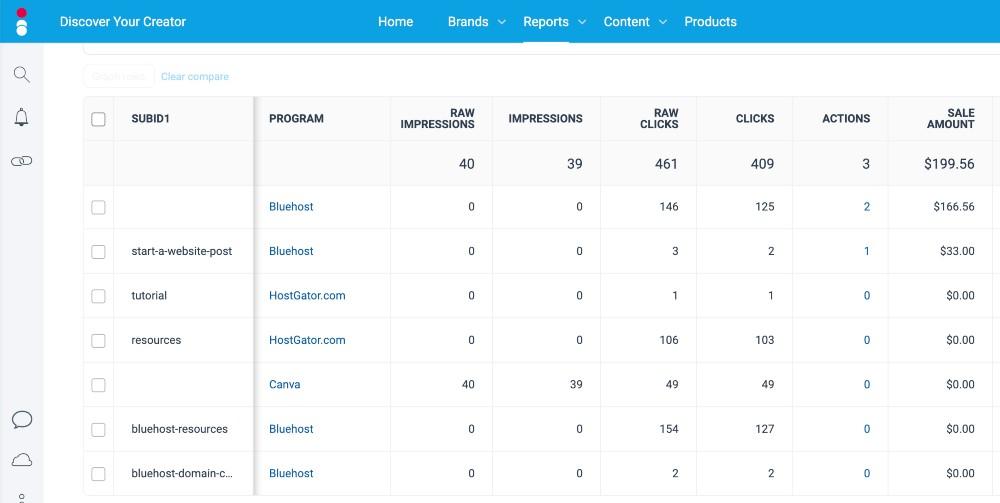![]() This post may contain affiliate links for the companies that I partner with. I may receive a commission if you purchase anything from these links. This is at no additional cost to you and I only recommend great companies that I personally use or have used. More info here.
This post may contain affiliate links for the companies that I partner with. I may receive a commission if you purchase anything from these links. This is at no additional cost to you and I only recommend great companies that I personally use or have used. More info here.
Affiliate marketing is one of the best ways to start monetizing a website or any type of content.
You can earn money through affiliate marketing fairly passively and without the time investment and risk of creating your own product.
I started off creating my own product (a diet program) with my first website and it was a big flop because I didn’t know how to sell or who I was even selling to.
Affiliate marketing is a great way to start learning what your audience is interested in and how to sell products to them before you create your own.
After the first product failure, I started over with a new website and a new strategy.
I started off with affiliate marketing and only when I had a handle on what I was doing and started selling affiliate products regularly and consistently did I dive back into creating my own products.
In this article, I’m going to cover everything you need to know about affiliate marketing for beginners, including:
- What is Affiliate Marketing?
- How Does Affiliate Marketing Work?
- How Much Can I Earn With Affiliate Marketing?
- How to Get Started with Affiliate Marketing for Beginners
- 6 Tips to Earn More with Affiliate Marketing
Let’s get started!
What is Affiliate Marketing?
Affiliate marketing is selling another person or company’s product or service in exchange for a commission of the sale.
You’re marketing a product to your audience and getting a kickback on any sales that you refer. This commission is often anywhere from 15-70% of the sale price and can also be recurring on for subscription products.
Affiliate marketing is a partnership between the marketer and the affiliate company or product owner. It’s a great way to make money as a blogger or content creator without having to create your own products to sell.
Even if you do have your own products to sell, it’s also a great way to supplement your income and earn money from recommendations you are already making.
For example, I recommend Bluehost web hosting services and ConvertKit email marketing services. I am an affiliate for these companies and I recommend them because I think they’re the best and I personally use them myself.
How Does Affiliate Marketing Work?
Affiliate sales are tracked through affiliate links, which are special links that you set up with the affiliate company that contain browser cookies to track clicks and purchases.
In order to start promoting products, you must first apply to an affiliate marketing network or company. Once approved, the company will provide you with a special link that tracks your sales.
When someone clicks on an affiliate link, a cookie is placed on their browser. These cookies usually last anywhere from 30-365 days and will track any purchases made within that time frame.
This means that someone doesn’t have to purchase through your link immediately. You will likely still get credit for the sale if they return to the website to purchase at a later date.
Here are the common reasons why you will NOT receive credit for a sale:
- The cookie window has expired.
- Cookies have been cleared from the browser.
- The person uses a different browser or device to make a purchase.
- The person clicked on someone else’s affiliate link after yours (replaces the cookie).
When someone makes a purchase using your affiliate link, the sale usually shows up in your affiliate dashboard. You can usually track your clicks and sales here but it depends on the reporting and analytics provided by the affiliate company or platform.
For example, Impact Radius is an affiliate platform that many companies use to host their affiliate programs. It comes with extensive link creation, tracking, and reporting.

You will usually get paid your affiliate earnings between 30 and 90 days after the sale is made, but some companies also set minimum payout requirements.
Make sure to check the minimum payout requirements before you apply. If you have to wait until you’ve earned $100 or more in sales to receive any payouts, this might not be an ideal option depending on how many sales you expect to make.
You’ll also need to consider affiliate rules regarding promotion and affiliate disclosures, which we’ll cover later on in this article.
How Much Can I Earn With Affiliate Marketing?
Affiliate marketing is great because you can earn anywhere from an extra $100 to $10,000 or more per month.
It depends on your affiliate marketing strategy, the traffic to your affiliate links, and what products are you promoting.
Most people start out by using affiliate marketing as a way to get started making money or just as a way to make some supplemental income from selling their own products.
But with the right strategy, you can earn well into the tens of thousands of dollars per month with affiliate marketing.
I’ve personally made over $50,000/month pretty consistently with another website of mine in the past. More on the best strategies to earn more with affiliate marketing later on.
How to Get Started with Affiliate Marketing for Beginners
The following steps will walk you through how to get started with affiliate marketing as a beginner and get your affiliate links set up the right way.
1. Find Affiliate Programs and Products
The first step is to find affiliate products or services to recommend. The best place to start is with the relevant products or services that you are already using or recommending to your audience.
For example, I’m an affiliate for Canva because I recommend it in my courses and use it daily in my own business.
You can find affiliate programs by searching online for “name of product/service + affiliate program” or “niche or topic + affiliate programs.”
There are also huge affiliate network marketplaces like Shareasale, Rakuten, Clickbank, Amazon Associates, and CJAffiliate that you can join and search for relevant products.

When you find an affiliate program to join, you’ll need to apply before you can begin promoting the products. Not everyone gets approved.
Here are some common requirements you’ll see in the application process:
- A link to your website
- How you plan to promote the product or service
- Links to your social media channels
- Expected sales or size of your audience
Some companies are stricter than others and some don’t have any requirements at all. It depends on the company.
It can take anywhere from a day or two to several weeks to get approved. Also, make sure to read all rules and disclosures first.
2. Review Affiliate Rules
Always make sure to read the affiliate company’s rules, terms, and conditions before applying.
Terms can vary, but here are some of the common rules to watch out for:
- Limitations on promotions: use of discounts, bonuses, or other promotions
- Private content restrictions: Prohibited links in emails, membership areas, PDFs, downloads, or other private or membership-based access
- Minimum sales: Minimum sale requirement, time period, or payout requirement
- Use of logo or images: Limited use of company-owned assets
- Special disclosures: Specific or more strict disclosures than what is required by law
Amazon Associates, for example, is known for having some very strict rules on promotion:
- No Amazon affiliate links in your emails, downloads, or membership-only areas.
- You must make 3 sales within your first 90 days or you will be removed from the program and have to reapply.
- Special disclosure is required on every page containing affiliate links. (Most people include this in the footer of their website.)
Affiliate rules can vary and violating these terms can cause immediate removal and potentially forfeited earnings.
3. Add Affiliate Disclosures
Before you start adding your affiliate links to your content, you must add affiliate disclosures to any content containing affiliate links.
It’s required by law to disclose your affiliate relationships openly to create transparency for consumers when making purchasing decisions.
People have a right to know that your recommendations may be influenced by the fact that you receive commissions on certain products that you recommend.
There are a lot of shady people on the internet that don’t recommend what’s best for their audience. They recommend what will give them the highest payout.
Don’t be one of those people. I’ll talk more about this later, but this isn’t the best and most sustainable strategy in the long term.
In the US, the Federal Trade Commission (FTC), is the governing body over consumer transactions online and they set the disclosure requirements. Here are a few helpful links:
These change from time to time, so try to stay on top of the requirements. They generally boil down to this:
Your affiliate disclosures must be clearly stated, easy to find, and generally (but not always) included BEFORE someone sees your affiliate link.
It’s not enough to have one small disclosure at the bottom of your website. It should generally be before your content or very close to the affiliate link. It shouldn’t be hard to find or in smaller, harder-to-read text.
The easiest way to add this disclosure to your articles is by using a free plugin like ad inserter that lets you add text automatically to all posts – wherever you’d like it.

4. Add Affiliate Links to Your Content
Once you’ve applied, been approved, and received your affiliate links, it’s time to add those links to your content.
Before you do this, I highly recommend disguising your links with a link cloaker plugin like Pretty Links.
This will help you keep your affiliate links organized and provide you with a place to easily update the links if your affiliate link ever changes (i.e. if the company were to move to a different platform).

The free version is plenty sufficient enough. Just add your affiliate link and create a new, “pretty” link using your domain name that you can add to your content.
When adding affiliate links to WordPress, make sure to also mark them as “No Follow” and “Sponsored.”
This is important for SEO and signals to Google that it’s a properly classified affiliate link.
You can add affiliate links in many different types of content, including:
- Blog posts or articles
- YouTube videos and descriptions
- Pinterest pins
- Instagram stories and descriptions
- Emails (depending on rules)
- Online courses (depending on rules)
- PDFs and other downloads (depending on rules)
A great place to start is with content that is already popular or getting traffic to it.
You should also create specific, affiliate-focused content to drive sales. The two best types of content for this are:
- Review articles or comparisons
- How-to articles (i.e. how to build an email list)
Make sure your affiliate links are visible and stand out. You can also add native buttons in WordPress when relevant:
5. Track Sales and Strategize
The great thing about affiliate marketing is that it can be fairly passive once it’s set up.
If you have an article that is getting Google SEO traffic that contains affiliate links and makes sales, you don’t generally have to do much more with it.
But before you reach the “set and forget” part, it’s important to check your analytics, monitor your performance, and see where you can improve your affiliate marketing strategy.
If you are able to create custom affiliate links within your affiliate dashboard, you can create “campaigns” or track affiliate sales in certain places.
For example, if an affiliate company is running a Black Friday sale with a discount and you are able to share this promotion, you can promote it to your email list along with a special link just for this sale.
After the sale is over, you can see how many sales you made and whether or not that promotion is worth your time.

If you sell an online course, you can add different affiliate links to your resources page, your articles, and other places to see exactly where and when those sales are coming from.
Do more of what’s working and less of what’s not working. If some products aren’t selling at all, it may be worth it to consider promoting an alternative product.
6 Tips to Earn More with Affiliate Marketing
I’ve been doing affiliate marketing for years now across multiple websites and niches. Here are my best tips and strategies for earning more from your efforts.
1. Create Affiliate-Focused Content
The first step is one that I already mentioned earlier, but I wanted to dive into a little more detail here.
Review articles and comparisons are by far the most effective type of articles to drive affiliate sales.
The thing is, when people are reading a review article, it means that they are likely already considering purchasing a product or service. They just want a little more advice or guidance before making a decision.
If you can be the one to provide them with that solution and confidence, they’ll click one of your links and buy.
The entire point of these articles is to promote affiliate products and services. This means that you shouldn’t just apply for the 1 product or service that you recommend above all others.
You should also apply to become an affiliate for every product or service that you include in your comparison, in case someone purchases a different product.
Here are a few example article titles of how you can do this:
- Top 5 Email Marketing Services for Content Creators
- ConvertKit vs. MailChimp: Which is Best for Email Marketing?
- How to Use ConvertKit to Build an Email List for Free
All of these articles present new and different ways to promote ConvertKit as well as other email marketing services. You can apply this to any product or niche!
2. Focus on Quality vs. Quantity
Review articles aside, it’s generally best to limit the number of affiliate links and recommendations to the most important products.
Sometimes, if you give people too many options, they won’t be convinced to buy anything. Instead, recommend what you truly believe is the best and most important.
This is a quality-over-quantity approach. For most of your content, it’s better to discuss fewer products in greater detail that you truly believe in rather than many products without much opinion or detail.
Remember that this is called affiliate marketing, and you are trying to sell (and convince someone to buy) something.
In my article on how to create a website, I recommend Bluehost as my #1 hosting company. I also list the other two most popular options: Hostgator and Siteground (which I am also an affiliate for).
But I don’t go into detail about these services except to say that my experience with Bluehost has been the best.
Stick to fewer companies and work on fostering better relationships with those companies, which is what I’ll cover next.
3. Build Partnerships and Relationships
Once you start making more affiliate sales, opportunities will arise to deepen your relationships with the affiliate companies that you promote.
Remember that this is ultimately a partnership from which both you and the affiliate company benefit. If you foster that relationship, you’ll have the potential to earn even more.
When you prove that you can earn enough sales, companies will notice and they will offer you additional incentives and rewards.
Two ways that I have greatly benefited from my affiliate marketing partnerships include:
- Personal discount for my audience – incentivizes people to purchase through your link
- Customized landing pages – build more trust with your audience and instills confidence in the purchase
- Joint-venture webinars – joint webinars with an affiliate company to advertise product benefits to my audience
- Guest blog posts – can build your domain authority and SEO and increase exposure
- Podcast interviews – additional exposure and reach
- Speaking opportunities – online conferences, panels, and other business opportunities
Most of these opportunities have come from my partnerships with Bluehost, Teachable, and ConvertKit – which incidentally are also the 3 most important tools that I’ve used to grow my businesses.
Now, it took time to get to this point. You will generally have to drive a lot of affiliate sales before you will be able to get on their radar.
The partnership also has to be worth the time for the affiliate company to invest back into you, and you generally have to show this value through sales first.
But this is something you should strive for in your most important affiliate partnerships and remember the rule of quality over quantity.
4. Free Trials and Discounts
Expanding upon my last point…
Remember that if you are ever able to give anyone incentive to purchase through your link (or purchase right now), you will be more likely to make the sale.
This is why offering any kind of discount is super effective. After you’ve started making consistent sales, reach out to the affiliate department and ask about discounts or other offers you can offer to your audience.
If you don’t have a discount available, free trials or free plans are also a bigger incentive, depending on your customer.
If your target audience is usually on a budget, as many people are, free trials and plans can incentive them to give the product or service a try risk-free.
This makes it more likely that they will stay on as a customer after the free trial or plan has ended if the product is great.
To get the most out of your ConvertKit plan, you’ll need the paid plan to access email sequences. But I still highlight ConvertKit’s free plan whenever possible to remind people that it exists and that it’s still a great place to start.
5. Try Before Buying
Trying a product before you recommend is recommended to make sure that the product is truly the best and one that your audience will be really happy with.
This isn’t a hard and fast rule and it also depends on the type of product that you’re recommending.
If you’re writing a comparison article on 10 different types of software, you don’t have to try out every single one personally before writing that article (although it’s always helpful).
But be careful with what you say. Don’t say that you have experience with a product or service if you actually don’t. That’s called lying.
You can still objectively tell someone about the product or service and what it does, but be careful about adding personal opinions when you haven’t tried it yet.
On the flip side, if you’re planning to recommend an online course or program or anything that is more specialized, you should consider trying it out first.
I once recommended a diabetes product in an article on my health website without trying it first, and I received a lot of customer complaints and refunds.
After I went ahead and purchased it to see what the fuss was about, I realized that the product did, in fact, suck – despite having a great sales page.
There is no quicker way to break trust with your audience than to recommend a low-quality product or service that isn’t worth their time or money.
6. Sell Higher-Priced Products
Lastly, remember that the price of the product matters. Generally, the higher the price of the product, the higher your commission will be.
If you earn $5 per sale in commissions, you’ll have to make 200 sales every month to reach $1,000/month. If you earn $50 per sale, you only have to make 20 sales to reach $1,000.
This is a lesson I learned early on when selling my first affiliate product (a yoga program) on ClickBank. I only earned about $5/sale and I wasn’t going to earn a living anytime soon at the rate I was going.
In this particular case, I decided to create my own yoga program instead – an eBook, actually (see my course on creating an eBook). I immediately started earning $27/sale rather than $5.
But even if you don’t want to create your own products, the principle is the same. Focusing on higher-priced products and higher commissions is the best way to scale your affiliate income.
Just remember that it can be harder to convince people to make larger investments. This is why selling higher-priced products with your email list can be really effective.
Look for products with higher commissions but make sure that this isn’t your only benchmark. It’s better to recommend a better product with a lower commission than a product that is subpar with a higher commission.
Trying before buying helps here too.
I’ve got an affiliate marketing course in the works, but it’s a restricted topic on Skillshare, so it’s on the backburner for now. It’s still on my list though and I will likely just release it on Udemy.
